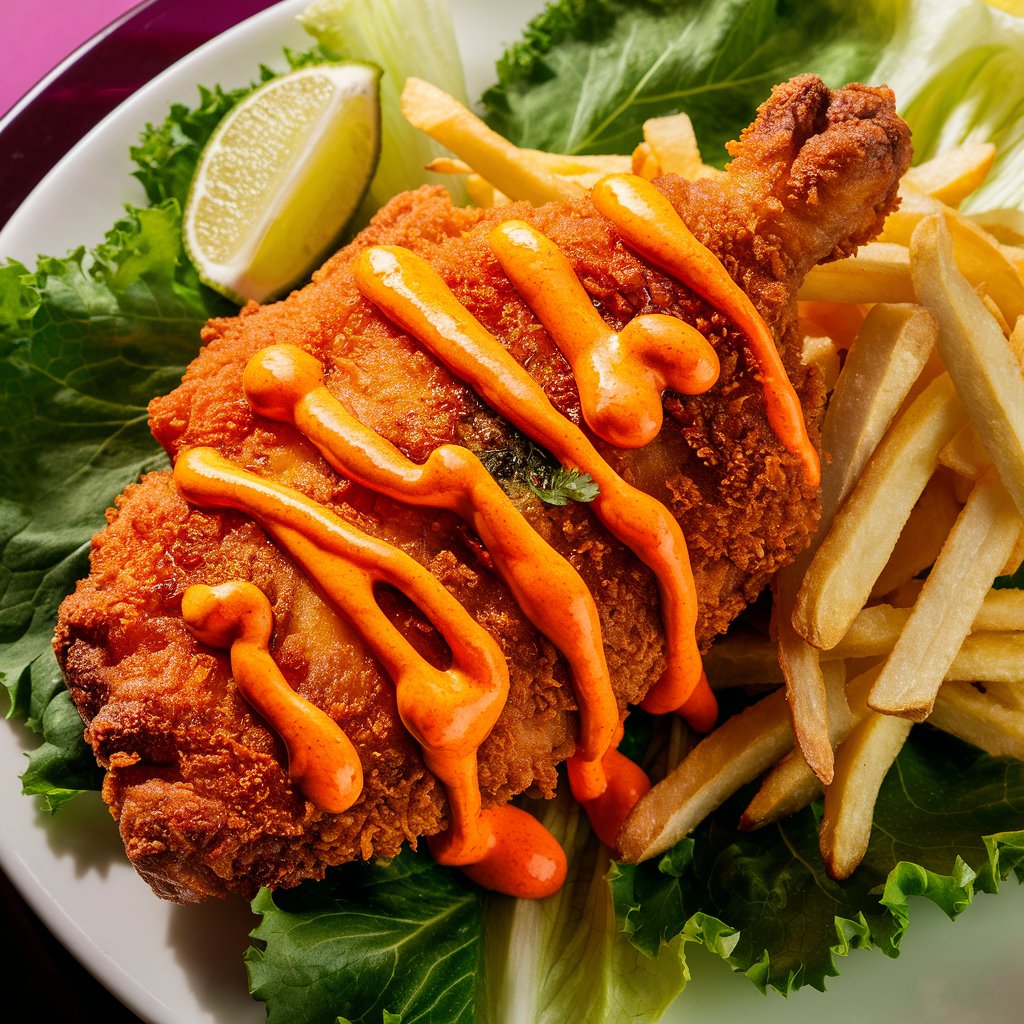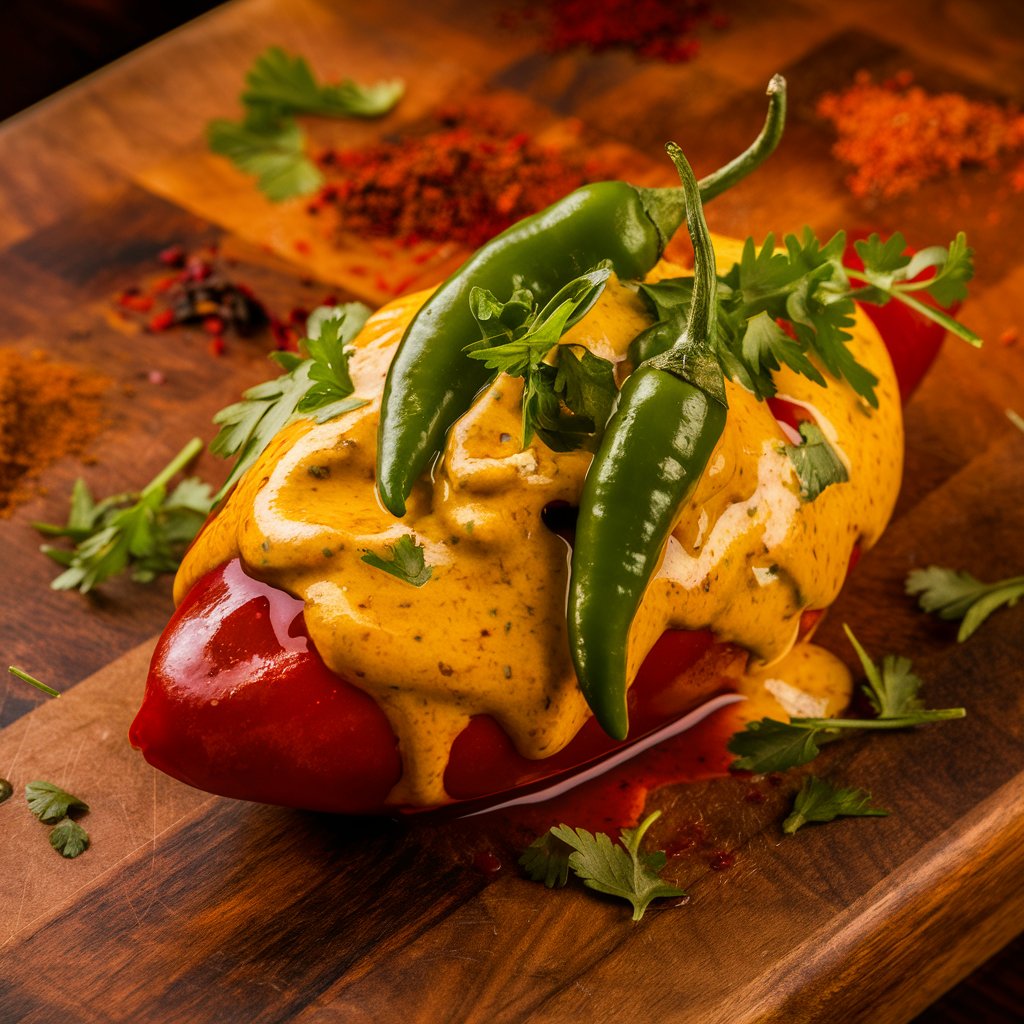Introduction to Spicy Mayo
Defining Spicy Mayo
Spicy mayo, or sriracha mayo, blends creamy mayonnaise with spicy elements like sriracha, hot sauce, or chili paste. Learn more about what spicy mayo is made of here. Traditional mayonnaise, made from egg yolks, oil, and vinegar or lemon juice, offers a rich base. When infused with spices, it becomes a versatile sauce that balances cool creaminess with fiery heat. Enhancements such as garlic, paprika, or herbs can enrich its flavor, making it a dynamic culinary addition.
Exploring Its Use in Global Cuisine
The popularity of spicy mayo has soared globally thanks to the rise of fusion cuisine, which mixes Asian and Western traditions. Originating in the United States with sushi rolls, it now graces a wide array of dishes worldwide.
Chefs and home cooks alike treasure its versatility. In Latin America, people drizzle it over tacos, burgers, and grilled meats. European bistros use it to enhance seafood, while it serves as a base for dips and spreads in the Middle East. Its preparation varies slightly by region, incorporating local spices and ingredients.
Why Spicy Mayo Continues to Thrive
Easy to prepare and universally appealing, spicy mayo continues to captivate global palates. As it travels, it absorbs local flavors, securing its status as a beloved condiment worldwide. This adaptation underscores the trend toward global fusion cuisines. In these dishes, culinary traditions merge to create new, delightful tastes.
Spicy mayo is not just a condiment; it is a multifunctional ingredient that enhances both the flavor and texture of various dishes. From its role in simple sandwiches to its use in complex marinades, spicy mayo offers a creamy texture and a spicy kick that can transform everyday meals into something special.
As a Condiment
Uses in Sandwiches and Burgers
In the realm of fast food and casual dining, spicy mayo has become a staple for sandwiches and burgers. Looking for inspiration? Try this Italian sandwich recipe for a gourmet twist. It provides a rich, creamy base that complements the savory flavors of meats and the fresh crispness of vegetables. By adding a layer of spicy mayo, a standard chicken sandwich or a classic burger gains an exciting twist that tickles the palate and elevates the overall flavor profile.
Spicing Up Traditional Dips and Salads
Beyond sandwiches and burgers, spicy mayo serves as a powerful enhancer for dips and salads. It can replace plain mayonnaise in recipes like potato salad or coleslaw, offering a zestier version of these traditional dishes. When mixed into dips, spicy mayo infuses them with a robust flavor that makes them more appealing and complex. It’s particularly popular in seafood dips, where it complements the sweetness of shrimp and crab.

As a Cooking Ingredient
Enhancing Marinades and Sauces
As a cooking ingredient, spicy mayo does wonders for marinades and sauces. It can be blended into a marinade for chicken, fish, or vegetables, adding a creamy texture and a spicy, tangy flavor that penetrates the food, enriching its taste and moistness. In sauces, a dollop of spicy mayo can smooth out the sharpness of vinegar or the richness of soy sauce, creating a balanced flavor that works well in stir-fries and grilling recipes.
Creative Recipes Incorporating Spicy Mayo
The versatility of spicy mayo encourages creativity in the kitchen. For example, it can serve as the base for a spicy version of aioli, used as a spread for gourmet toasts or as a dip for artichoke hearts. Innovative chefs have used spicy mayo in sushi rolls, where it adds a creamy, spicy layer to the umami-rich flavors of fish and rice. Another creative use is in mayo-infused dressings for trendy grain bowls, where it unites diverse ingredients like quinoa, vegetables, and protein into a harmonious dish.
In conclusion, the culinary applications of spicy mayo are vast and varied. Its ability to adapt to different dishes and cuisines makes it a beloved ingredient in kitchens worldwide. Whether used as a condiment to add a simple spicy touch or as a key ingredient in complex recipes, mayo continues to inspire culinary creativity and delight taste buds with its unique blend of creaminess and heat.
Ideal Food Pairings for Spicy Mayo
mayo enhances a wide array of dishes with its creamy texture and spicy kick. It complements everything from fast food to gourmet dishes and home-cooked meals.
Fast Food Enhancements
French Fries and Potato Wedges
A classic pairing for spicy mayo is French fries and potato wedges. This combo is popular in many fast-food restaurants and bars. The creamy, spicy mayo elevates the simple, crispy texture of the fries. It also seeps into the fluffy interiors of thicker-cut potato wedges, providing delicious contrast.
Fried Chicken and Fish Tacos
Fried chicken and fish tacos pair beautifully with spicy mayo. The sauce adds a moist, spicy layer to the crunchy batter of fried chicken. For fish tacos, it enhances flavors and binds ingredients like cabbage slaw and cilantro. This creates a cohesive and flavorful experience.
Gourmet and Home Cooking
Gourmet Sandwiches and Wraps
Spicy mayo transforms gourmet sandwiches and wraps. It can be spread on artisan breads or infused into wraps. This adds a creamy texture and fiery kick that balances with ingredients like roasted vegetables, specialty cheeses, and premium meats. For example, it elevates the flavors of a turkey avocado wrap or a grilled vegetable sandwich.

Innovative Uses in Home-Cooked Meals
At home, spicy mayo inspires culinary creativity. It can transform a simple baked potato when used as a topping mixed with herbs and spices. It’s also excellent in homemade burgers, mixed into the meat or as a condiment. This provides a creamy texture and a burst of spice that elevates the homemade burger experience.
Adventurous home cooks might use mayo in pasta sauces or as a base for creamy, spicy salad dressings. These innovative uses show the flexibility of mayo and its ability to adapt to different cooking styles and ingredients.
mayo is more than a condiment; it’s a culinary staple that enhances various dishes. From snacks like fries to substantial meals like gourmet sandwiches, it provides a delicious, spicy twist that complements and elevates flavors. Its universal appeal lies in its blend of creaminess and heat, making it a favorite for those looking to spice up their meals.
DIY Spicy Mayo Recipes
Creating your own spicy mayo at home is a straightforward and rewarding process. Discover more easy sauce ideas in our Quick Kitchen Sauce guide. With just a few basic ingredients, you can whip up a custom batch that fits your taste preferences and spice tolerance.
Basic Ingredients and Preparation
To start, you’ll need the following ingredients:
- 1 cup of mayonnaise
- 2 tablespoons of sriracha or any preferred hot sauce
- 1 teaspoon of lime or lemon juice
- A pinch of salt
- Optional: 1 minced garlic clove for added depth
The preparation process is simple. In a bowl, combine the mayonnaise with your choice of hot sauce. Add the lime or lemon juice and a pinch of salt. If you like, include minced garlic for extra flavor. Mix all the constituents until they’re well amalgamated. Taste and acclimate the seasoning if necessary. Your racy mayo is now ready to enhance any dish.
Variations and Flavor Adjustments
While the basic spicy mayo recipe is quite popular, you can easily customize it to suit your taste.
- For a smoky twist: Add a teaspoon of smoked paprika to the mix. This gives the mayo a deep, smoky flavor that pairs well with grilled foods.
- For extra heat: Incorporate a teaspoon of chili flakes or a bit of chopped jalapeño. This will increase the spiciness for those who enjoy a more intense heat.
- For a sweet note: Blend in a tablespoon of honey or maple syrup. This addition balances the heat with a subtle sweetness.
- For an Asian flair: Mix in a tablespoon of soy sauce and a teaspoon of sesame oil. This version goes exceptionally well with sushi or as a dip for dumplings.
You can also experiment with different types of mayonnaise or create your own from scratch using egg yolks and oil for an even fresher taste. These variations allow you to tailor your spicy mayo to specific dishes or personal preferences, making it a versatile addition to your culinary toolkit.
By following these simple guidelines and experimenting with various adjustments, you can master the art of making mayo at home, ensuring you have the perfect condiment to spice up your meals anytime.
Nutritional Aspects of Spicy Mayo
Spicy mayo, while delicious, is a condiment that carries a significant caloric load primarily due to its mayonnaise base. Understanding its nutritional profile can help you enjoy it responsibly and harness its health benefits.
Caloric Content and Health Benefits
Typically, mayo is made from mayonnaise, which is a mix of egg yolks, oil, and an acid like vinegar or lemon juice. This combination results in a high fat and calorie content. One tablespoon of spicy mayo can contain approximately 90-100 calories, with most of these calories coming from fats. However, not all aspects of spicy mayo are negative from a nutritional standpoint.
The addition of spicy components like sriracha or chili peppers introduces capsaicin, which is known for its health benefits. Capsaicin has been shown to boost metabolism, aid in weight loss, and even provide anti-inflammatory effects. Furthermore, small amounts of antioxidants and vitamins from added ingredients like garlic or lime juice contribute to the overall nutritional value of the sauce.
When to Use in Moderation
Despite its appealing flavor, spicy mayo should be used in moderation due to its high caloric and fat content. It’s wise to consider the amount used, especially if you’re mindful of calorie intake or managing dietary fat levels. Additionally, commercial mayo can contain added sugars and preservatives, increasing the need for careful consumption.
Using spicy mayo sparingly can help maintain a balanced diet while still enjoying its unique taste. It’s perfect for adding a flavor boost to dishes without overwhelming them. For a healthier alternative, consider using reduced-fat mayonnaise or yogurt as the base for homemade mayo, reducing the overall caloric impact while still delivering the creamy texture and spicy kick.
Understanding these nutritional aspects helps you incorporate spicy mayo into your diet wisely, ensuring you can enjoy its taste without compromising your health goals.
Frequently Asked Fried Chicken and Fish Tacos Spicy mayo is also perfect for drizzling over fried chicken or incorporating into fish tacos. It adds a creamy, spicy dimension that meshes well with the crispy chicken and the flavorful fillings of tacos.Don’t miss our detailed guide on how long to cook meatloaf at 375 for perfectly cooked meals.Questions
What are the best dishes to try with spicy mayo?
Spicy mayo is incredibly versatile and can enhance a wide range of dishes. It pairs exceptionally well with seafood, such as sushi rolls and fish tacos, providing a creamy texture and a spicy kick. It’s also excellent on burgers and sandwiches, adding depth to the flavors. For appetizers, try dipping French fries, onion rings, or sweet potato fries in spicy mayo for an extra burst of flavor. It also works well in wraps, salads, and as a drizzle over roasted vegetables.
Can spicy mayo be used in vegan recipes?
Absolutely! To make vegan spicy mayo, simply substitute the traditional mayonnaise with a vegan mayonnaise, which is typically made from plant-based oils and does not contain eggs. Vegan mayo can be used just like the traditional version, making it a perfect addition to vegan sushi, sandwiches, and dips. It retains the creamy texture and spicy flavor, ensuring that no compromise is made on taste in vegan dishes.
How can I make a healthier version of spicy mayo?
Creating a healthier version of mayo is easy and can be done by substituting some or all of the mayonnaise with alternatives like Greek yogurt or avocado. Greek yogurt provides a creamy texture with a fraction of the fat and calories and adds a tangy flavor. Avocado is another excellent option, offering healthy fats and a buttery texture. For an even lighter version, mix in some sour cream or silken tofu. Adjust the amount of spicy elements according to your taste to maintain the kick that is known for. These substitutions not only lower the calorie and fat content but also enhance the nutritional profile of the condiment.
Conclusion
mayo has transcended its origins as a simple condiment to become a globally beloved addition to various dishes. Its creamy texture combined with a spicy kick allows it to enhance the flavor profiles of both everyday and gourmet foods, making it a staple in kitchens around the world. From fast food to fine dining, brings an exciting dimension to meals, whether it’s adding a zesty twist to burgers and sandwiches or complementing the delicate flavors of sushi and seafood.
The versatility of also extends to its adaptability in recipes, allowing cooks at all skill levels to tailor it to their dietary preferences and health considerations. Whether making a traditional recipe or a vegan, low-fat version, the basic elements of mayo can be adjusted to suit different nutritional needs and culinary contexts. This adaptability is key to its widespread popularity and enduring appeal.
Moreover, the health benefits associated with the capsaicin in spicy mayo—such as metabolism boosting and anti-inflammatory properties—provide additional incentives for incorporating this condiment into meals, albeit in moderation. By making informed choices about the ingredients, such as opting for healthier bases like Greek yogurt or avocado, food lovers can enjoy the unique flavors of spicy mayo without compromising their health goals.
Wikipedia on Capsaicin: This Wikipedia entry provides detailed information about capsaicin, the spicy component of chili peppers, including its uses in food and medicine, its chemical properties, and health implications. You can read more about it here: Capsaicin – Wikipedia.
In conclusion, mayo is more than just a sauce; it’s a culinary phenomenon that has captured the imaginations of chefs and home cooks alike. Check out more ideas on what goes with spicy mayo. Its ability to elevate the mundane to the extraordinary with just a dollop makes it a cherished ingredient in diverse culinary traditions. As it continues to evolve, will undoubtedly inspire more innovative dishes and remain a favorite flavor enhancer in kitchens worldwide.

What goes with spicy mayo?
5 Stars 4 Stars 3 Stars 2 Stars 1 Star
No reviews
- Author: ava salmon
- Total Time: 5 minutes
- Yield: 1 cup 1x
Description
Discover the best pairings for spicy mayo, including sushi, fries, tacos, and gourmet sandwiches. Plus, learn how to make your own quick spicy mayo at home with simple ingredients.
Ingredients
(For Homemade Spicy Mayo)
- 1 cup mayonnaise (regular or vegan)
- 2 tablespoons sriracha or hot sauce
- 1 teaspoon lime or lemon juice
- 1 pinch salt
- Optional: 1 minced garlic clove
(Suggested Pairings)
- French fries or potato wedges
- Fried chicken or fish tacos
- Gourmet sandwiches or wraps
- Sushi rolls
- Roasted vegetables
Instructions
1. Prepare the Spicy Mayo:
- In a small bowl, combine mayonnaise and sriracha.
- Add lime juice and salt; mix well.
- For extra depth, stir in minced garlic.
2. Taste and Adjust:
-
Add more sriracha for heat or a dash of honey for sweetness.
3. Serve:
Drizzle over sushi, tacos, or use as a dip for fries and veggies.
Notes
- For a healthier option: Substitute half the mayo with Greek yogurt or mashed avocado.
- Store spicy mayo in an airtight container in the fridge for up to 5 days.
- Adjust spice level to suit your preference.
- Prep Time: 5 minutes
- Cook Time: 0 minutes
- Category: Sauce/Condiment
- Method: Mix
- Cuisine: Fusion










